#local indian cuisine
Text
9 Must-Try Foods in Varanasi
Varanasi also known as Benaras/ Kashi is one of the oldest living cities in the world. It iis not only a spiritual haven but also a food lover’s paradise. The narrow lanes of this beautiful ancient city are lined with food stalls and eateries offering a wide variety of delectable dishes that are unique to this region.
Here are nine must-try foods that will give you a true taste of Varanasi.
1.…
#Best eats in Varanasi#Food lovers Varanasi#indian cuisine#Local delicacies in Varanasi#Must-try foods in Varanasi#Traditional Varanasi foods#Travel food guide#Varanasi culinary journey#Varanasi food guide#Varanasi street food
0 notes
Text
Discovering Bhutan: The Last Shangri-La
Nestled in the Eastern Himalayas, Bhutan, known as the “Land of the Thunder Dragon,” is a country that beckons travelers with its pristine landscapes, vibrant culture, and profound spirituality. As one of the world’s last remaining Buddhist kingdoms, Bhutan offers a unique blend of ancient traditions and modern sensibilities. In this travel guide, we’ll explore Bhutan’s history, political…

View On WordPress
#" is a country that beckons travelers with its pristine landscapes#adventure#africa#all international tourists (excluding Indian#all international tourists need a visa arranged through a licensed tour operator#and a guide#and a guide. This policy helps manage tourism sustainably and preserves the country&039;s unique culture. Currency and Bank Cards The offic#and archery. Safety Bhutan is one of the safest countries for travelers. Violent crime is rare#and Buddha Dordenma statue. Punakha: Known for the majestic Punakha Dzong#and cultural insights to help you plan an unforgettable journey. Brief History of Bhutan Bhutan&039;s history is deeply intertwined with Bu#and Culture Religion: Buddhism is the predominant religion#and experiencing a traditional Bhutanese meal are top cultural activities. Is it safe to travel alone in Bhutan? Bhutan is very safe for sol#and Kathmandu. Infrastructure and Roads Bhutan&039;s infrastructure is developing#and Maldivian passport holders) must obtain a visa through a licensed Bhutanese tour operator. A daily tariff is imposed#and red rice. Meals are typically spicy and incorporate locally sourced ingredients. Culture: Bhutanese culture is characterized by its emph#and respectful clothing for visiting religious sites. Bhutan remains a land of mystery and magic#and stupas are common sights. Food: Bhutanese cuisine features dishes like Ema Datshi (chili cheese)#and the locals are known for their hospitality. However#and vibrant festivals. Handicrafts#Bangladeshi#Bhutan#Bhutan offers a unique blend of ancient traditions and modern sensibilities. In this travel guide#Bhutan promises an experience unlike any other. Plan your journey carefully#Bhutan was never colonized. The country signed the Treaty of Sinchula with British India in 1865#but English is widely spoken and used in education and government. What should I pack for a trip to Bhutan? Pack layers for varying temperat#but it covers most expenses#but it&039;s advisable to carry cash when traveling to remote regions. Top Places to Visit in Bhutan Paro Valley: Home to the iconic Paro T#but it&039;s advisable to carry cash when traveling to rural regions. What are the top cultural experiences in Bhutan? Attending a Tshechu#but they offer stunning views. Religion#comfortable walking shoes
0 notes
Text
Exploring the Eternal Charm of Goa: A Day of Sun, Sea, and Connections
On the golden shores of Goa, the sun casts its generous glow, infusing the morning with a hue of molten amber as it kisses the placid Arabian Sea. Waves lap lazily against the sun-drenched sand, painting a lullaby that whispers of eternal calm. It’s a fresh morning, the air still holding onto the crisp serenade of dawn, the kind that seeps deep into your lungs and makes you believe in ancient…

View On WordPress
#beach life#community life#daily rituals#Goa#Indian culture#local cuisine#seaside experiences#spiritual India#traditional art#travel in India
0 notes
Text
Lonely Planet’s Best Bike Rides Australia
Get on your bike and ready to roll on a pedal-powered journey across the breathtaking landscapes of Australia with Lonely Planet's latest release: Best Bike Rides Australia.
Get on your bike and ready to roll on a pedal-powered journey across the breathtaking landscapes of Australia with Lonely Planet’s latest release: Best Bike Rides Australia.
Sunshine Coastal Pathway
Running alongside the ocean from Mooloolaba Beach to the mouth of Maroochydore River, the Sunshine Coastal Pathway offers up a slice of Sunshine Coast lifestyle in under an hour. Every morning,…

View On WordPress
#active holidays#Adelaide foreshore#adventure travel#art and culture#Australia cycling#Australian landscapes#beachfront paths#bike rides#Coast Park Path#coastal pathways#coastal towns#cycling tourism#e-bike rentals#environmental conservation#family-friendly cycling#Fremantle exploration#heritage sites#historical landmarks#Indian Ocean Explorer#local cuisine#Lonely Planet#Maroochydore River#mountain biking#nature exploration#New South Wales coast#outdoor activities#Perth coastline#picnic spots#recreational cycling#scenic trails
0 notes
Text
Local Mexican Cuisine In Nairobi | Events In Nairobi This Weekend
Nairobi Street Kitchen offers a taste of Kenya's unique flavours. From delectable nyama choma to traditional ugali, our menu honours New Breakfast Place In Nairobi, Kenyan cuisine's rich past. Come experience Nairobi's unique culinary culture with us.
#Events In Nairobi This Weekend#Indian Street Restaurant In Nairobi#New Breakfast Place In Nairobi#Happy Hour Nairobi#Social Restaurant Nairobi#Local Mexican Cuisine In Nairobi#Upcoming Events In Nairobi#Dine In Mexican Restaurants In Nairobi#Places To Go For Dinner In Nairobi
0 notes
Text
Vocal For Local - New India 🇮🇳 Voice
Vocal For Local – New India 🇮🇳 Voice
Vocal For LocalVocal for Local is a campaign to promote local/Indian products/services in the market that are competitive with global standards and can capture the spirit of local brands in both domestic and international markets.Products should be “Made In India” & promoted to make them competitive. During the Independence Day speech in 2020, Prime Minister Modi said; “The mindset of free India…

View On WordPress
#Business#Buy Local#Buy Local Services#domestic market#Dress National Costumes#Eat Indian Cuisines#India#industry#international market#made in India#market#Modi#Narendra Modi#New India Voice#Prime Minister#product#Promote Local#self reliant India#Self-reliant#Service#small scale business#Startup#Travel In India#Vocal For Local#Voice
0 notes
Text

[ID: A greyish brown stew presented alongside flatbread, red pepper paste, green peppers, and carrot sticks. End ID]
سماقية / Summagiyya (Gazan stew with chard, chickpea, sumac, and 'lamb')
Summagiyya (سُمَّاقِيَّة; also translitered "sumagiyya", "sumaghiyyeh" or "sumaqiyya") is one of the signature dishes of the Gaza strip, in particular Gaza City. It consists of lamb, chard, and chickpeas in a sumac-infused broth; savor and zest is added by a dagga of dill seeds, garlic, and peppers, and nutty depth by a generous drizzle of red tahina. The resulting stew is thick, earthy, and slodgily grey (due to the green chard and red sumac)—it also has the characteristic sourness of much Gazan cuisine.
Summagiyya is most often prepared during holidays, especially Eid al-Fitr; it's an excellent make-ahead dish for these occasions, since it's even better once its flavors have had time to meld and mellow overnight. It is served cold alongside fresh vegetables, and eaten by using flatbread to scoop up each bite. This recipe provides a spiced seitan recipe to replace the lamb, but you may also use any lamb or beef substitute of your choice.
Today, summagiyya is often prepared with Israeli white tahina, as decades of punitive import laws, taxes, and restrictions have enforced Palestine's status as a consumer, rather than an producer, of food products. Israeli tariffs on, and confiscations of, Palestinian goods have forced those tahina factories that survived to import sesame seeds rather than using locally grown crops, even as they export the best of their product to Israel. The dubbing of foods such as tahina and hummus as culturally "Israeli" cuisine works to hide this exploitative relationship, and cement an Israeli national identity through the subsuming and erasure of Palestinian existence. It is for this reason that Emad Moussa writes that Palestinian cuisine has a role in "protecting against a people's very extinction."
Medical Aid for Palestinians (MAP) has put out an urgent call for donations to provide medical supplies to Palestinian hospitals when supply lines reopen. Also contact your representatives in the USA, UK, and Canada.
Ingredients:
For the soup:
500g (2 large bunches) chard (شلق), diced
80g Levantine sumac berries (Rhus coriaria)
1/2 cup soaked and boiled chickpeas, mostly cooked (40g dry / scant 1/4 cup)
1/4 cup red tahina
1/2 cup (60g) all-purpose flour
1 large yellow onion
1/4 cup olive oil
1 tsp kosher salt
2 cardamom pods (optional)
2 allspice berries (optional)
More olive oil, to fry
Sumac berries can be found in the spice section of a halal grocery store. If you're unable to locate whole berries, pre-ground will do.
For the dagga:
1 1/2 Tbsp dill seeds
5 cloves garlic
1/2 green cubanelle pepper
2-3 dried red chilis (optional)
1/2 tsp black pepper
1/4 tsp cumin
Dill seeds may be found at a halal, south Asian, or speciality European grocery store. They are commonly used in Indian food and as a pickling spice. At a south Asian grocery store they may be labelled soyo, suva, shepu, or savaa.
For the lamb:
1 cup (120g) vital wheat gluten, aka gluten flour
1/2 Tbsp ground sumac
1/2 tsp ground caraway
1 tsp onion powder
1 tsp Palestinian 7-spice
1/2 tsp garlic powder
1/2 tsp sea salt
1/2 tsp ground black pepper
1/2 tsp ground cumin
1/2 tsp ground aniseed
1/2 tsp turnermic
1 tbsp olive oil
1/2 tsp soy sauce
1 tsp miso paste
2 cloves garlic, grated
2 tsp pomegranate molasses
1 Tbsp white or red tahina
About 1/2 cup vegetarian 'beef' stock from concentrate, or vegetable stock
Pomegranate molasses is simply pomegranate juice that has been reduced to a thick consistency. It may be found in the sauces section of a halal grocery store.
Instructions:
For the soup:
1. Soak dried chickpeas in cool water overnight, or in just-boiled water for an hour. Drain and re-cover with water, and boil for 30-45 minutes, until almost fully cooked. Drain and set aside.
2. Simmer sumac seeds in enough water to cover by a couple inches for about an hour, until the water is dark red. Blend the seeds and water together, then strain the mixture through a cheesecloth.
If you're using ground sumac, skip the blending step. Use a cheesecloth or very fine metal sieve (such as one intended for brewing tea) to remove the ground spice from the water.
3. Whisk the flour into the sumac-infused water.
For the lamb:
1. Combine all dry ingredients in a large mixing bowl. Add wet ingredients other than stock and stir briefly. Add enough stock to produce a soft, smooth dough.
2. Knead by hand on a clean surface, or put in a stand mixer with paddle attachment on medium-low, for about 5 minutes. You should see stringy strands begin to form in the dough.
3. Allow to rest, covered, for 5-10 minutes to encourage gluten formation. Knead for another 3 minutes. Do not over-knead.
4. Tear the dough into bite-sized pieces.
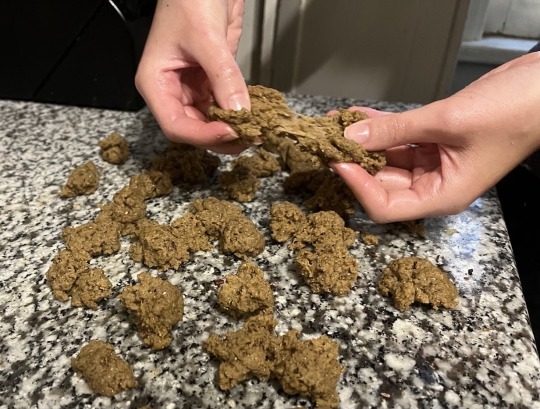
Stringy seitan being pulled apart into pieces.
You may also shape the dough into a slab and cube it with a sharp knife—the lamb or beef used in summagiyya is usually cubed—but I prefer the texture of torn seitan to sliced.
5. Steam the seitan pieces for 10 minutes in a bamboo steamer or using a metal steamer basket. Place the bamboo steamer in the bottom of a wok and cover its base by about 1/2" (1 cm), then raise the heat to boil the water; lower the heat to keep the water at a simmer. If using a steamer basket, place it over the opening of a pot containing a couple inches of water and bring it to a simmer. Start the timer when the water begins simmering.
6. Heat olive oil on medium-high and sear the steamed seitan pieces, turning as necessary, until deeply browned on all sides. Set aside.

Fried seitan pieces.
You can save a step here by searing the raw seitan, then returning it to the pot after you've fried the onions to simmer it rather than steaming. I found that this produced a mushier texture.
For the dagga (دقة):
1. Grind cumin and black pepper thoroughly in a mortar and pestle, then add dried red pepper and dill seed and crush coarsely. Add green sweet pepper and garlic and pound until a coarse mixture forms.
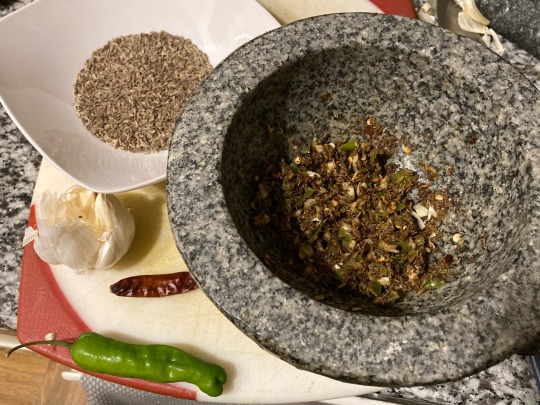
Dill seeds, green sweet pepper, garlic, and dried red chili on a cutting board, alongside dagga in a large granite mortar.
You may also use a spice mill or food processor.
To assemble:
1. Chop the onion. Wash the chard and slice it thinly in one direction; turn it ninety degrees and slice thinly again.
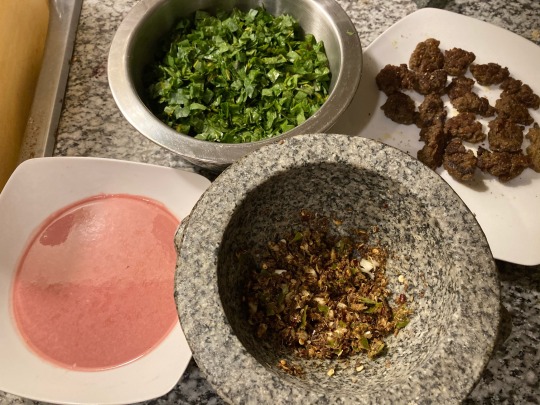
Diced chard, fried seitan, dagga, and sumac-infused water with flour.
2. In a large pot, heat a couple tablespoons of olive oil on medium. Fry chopped onion, cardamom pods, and allspice berries for a minute until fragrant. Add half of the dagga and fry until fragrant.
3. Add chard and fry, mixing often, until wilted.
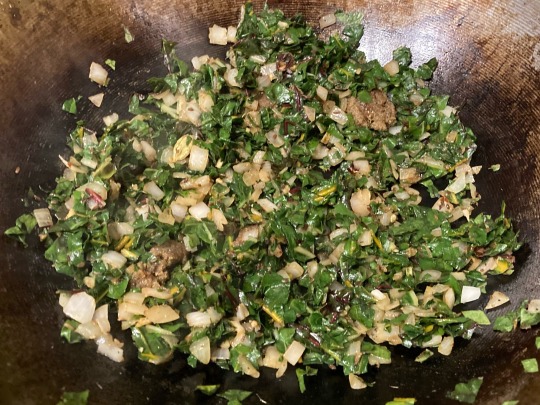
Wilted chard in a wok.
4. Add sumac mixture, chickpeas, and water to cover. Bring to a boil, then lower heat to a simmer. If you didn't steam your seitan earlier, add it now.
5. Continue to stir and simmer until the stew is thick, homogenous, and greyish-brown, about 15 minutes.

Simmered stew.
6. Add the remainder of the garlic mixture, the red tahina, a pinch of ground cumin, the 1/4 cup olive oil, and salt to taste. Return the steamed and seared seitan to the pot and mix.
Serve cool with flatbread, sweet green peppers, bitter green and black olives, carrots, leafy greens, and/or pickles.
#vegetarian recipes#vegan recipe#vegan cooking#Palestinian#Gazan#chickpeas#lamb#seitan#chard#dill seeds#pomegranate molasses
488 notes
·
View notes
Note
You seem like a good sort of person to ask; how does one go about building up a good spice rack? Not only just having the spices, but knowing what they are and how to use them, when and in what quantities, and developing a wider spice palette in general? I grew up in white suburbia and my mother has no idea how to use anything other than salt and ground black pepper, and I want to start making my foods more flavorful. I am tired of utterly flavorless dry roast pork! But I have no idea where to begin lol.
I'd say to start by trying a lot of foods that use a lot of different spice profiles and seeing what you like. If you like Thai food, look into Thai spices and try cooking a few recipes. If you like Indian food, try Indian recipes. If you don't know if you like a particular kind of food, go out and try it and see if you do.
I think the best way to build up your spice rack is to do so slowly over time as you familiarize yourself with different flavors. Don't go out and buy a ton of stuff, go out and buy cumin and make a rice recipe that calls for cumin and see if you like it, then next time maybe add another spice like cayenne pepper to the recipe and see if you like it.
Spices can be really expensive, but they can also be really cheap if you're looking in the right places. Try to avoid the shiny organic spice jars, and see if there are packets of spices in the various "ethnic" food sections of your grocery store (in California it's pretty common to have a Mexican food section and an Asian food section in the store and you'll often find stuff like a packet of cumin for 70 cents that's got the same amount of spice as the organic jar that costs five bucks in the spice aisle).
Once you've got some basics down, start branching out and seeing if you've got any good markets nearby that have more unusual spices. Large Bastard and I get most of our bulk spices from a Middle Eastern market around the corner from our house or at an Indian market a few miles away because it's WAY cheaper to get allspice or turmeric or garam masala from those stores than it would be from the grocery store.
And if you're starting at the basic-basics, like how to season a simple pork roast, check recipe blogs. Find different bloggers and test their recipes until you find someone you trust, then follow their recipes. One good place to start is with Chef John and Food Wishes - he has a wide variety of cuisines that use a lot of different spices and has recipes that range from very simple to very complex.
youtube
Large Bastard really likes Food Wishes and trying recipes from Chef John - he cooks less than I do and has less of a sense of what to add to a pot to get something to taste the way he wants it to, but he's gotten very good at taking Food Wishes recipes and tweaking them or adjusting them and figuring out how to mix and match flavors.
Just cooking - finding a recipe that looks interesting and following it - is a really good way to get better at this kind of thing.
That's actually one of the reasons that I think meal kit boxes like blue apron can be worth it for people who want to learn how to cook - they give you recipes you wouldn't have thought to look for and provide small amounts of the required ingredients so you can sample them and figure out if you like them. My dad and sister got blue apron for like two years and it has significantly improved their cooking skills and ability to mix and match flavors.
It just takes time and money and trial and error. Easy, right? (It isn't, but there's also no way to make it faster other than doing more experiments. Thankfully there are ways to make it cheaper, and yeah looking at local specialty markets is a good way to save on spices)
230 notes
·
View notes
Note
do you think the lamb stew kabru mentioned could be some variation of rogan josh?
omg anon I'm so sorry, you sent this message just when my life was going completely insane (tree fell on house, living in a hotel, etc), and I wanted to answer you but I just didn't have time... So I forgot.
And then another anon (or maybe it's still you!) sent me another, similar ask!

Which reminded me that I needed to answer you-- and now them, too!!
Food is not an area of expertise for me, so I had to look up all of these dishes. I'd heard the term "gorkhali" before, and heard of rogan josh, but that's as far as my knowledge went.
Let's talk about what we know about where Kabru comes from and what foods he likes, the food culture of South Asia in the real world, and then we can discuss if any of these dishes might be Kabru's childhood lamb stew!
I've written about the real world cultural references Kui has made with Kabru's character before. Evidence that Kabru is from a fantasy version of South Asia (India/Nepal), and Where exactly in fantasy South Asia is Kabru possibly from?
Two additional data points that suggest Kabru could be from a fantasy version of South Asia are his love of tomatoes, and mutton stew being an important dish from his childhood. What does that mean?
THE CULTURAL OVERLAP BETWEEN INDIA, NEPAL AND TIBET
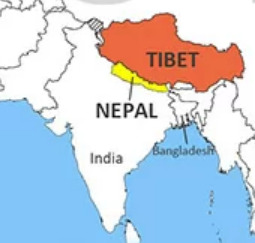
An important thing to note while discussing the cultures of this region is that all three modern countries have a lot of cultural overlap. So many of the foods eaten in one country are also eaten in the other two, with minor variations.
I'm attempting to generalize and speak broadly as best I can, but I am not an expert, so I apologize for any errors on my part. Sometimes finding English-language information on these topics is challenging.
The cuisine of Nepal is a mix of Nepal's own unique culture, plus the influence of its neighbors, India and Tibet.
The Nepali diet primarily consists of rice, wheat, corn, lentils coupled with fresh vegetables and meats. A typical Nepali every-day meal can be characterized by Dal (lentil soups), Bhat (steamed rice) and Tarkari (vegetables), also known as "The Trinity", supplemented by some meat.
STEW OR CURRY?
Though many people think of them as two distinct things, curries are a type of stew, so I think it's valid to look at both stews and curries when trying to identify Kabru's childhood stew.
TOMATOES IN THE CUISINE OF THE INDIAN SUBCONTINENT
Tomatoes turn up in dishes all over the Indian subcontinent, but they are not a traditional ingredient in the local cuisine. Europeans introduced New World foods like chilies, potato and tomato to the region in the 16th century, at which point they were added to the food culture, and in many cases the modern version of these recipes has completely eclipsed the traditional one, both on the Indian subcontinent and abroad.
But while potatoes and chilies were adopted almost immediately, the tomato did not catch on until centuries later, in the 1860s, and they did not become a widespread part of the local culture until the 1960s.
Because of this, the popular global idea of food from the Indian subcontinent often has tomatoes in it, while traditional recipes do not... And this is interesting because Kui tells us Kabru's favorite food is tomatoes! I'm guessing she chose tomatoes because of how common they are in modern Indian food.
Did Kui not know that tomatoes aren't a native part of the cuisine of the Indian subcontinent? It's possible her research didn't go that deep and she just assumed the modern food isn't that different from ancient food.
It's also possible that Kui knew that tomatoes aren't native to the Indian subcontinent, but that Dungeon Meshi has already experienced their version of the Colombian Exchange, because the east and west have had extensive contact with each other for (probably) thousands of years, so then the use of tomatoes in the West (where Kabru is from) would make sense, and doesn't need any further explanation.
MUTTON IN THE INDIAN SUBCONTINENT
Mutton (the term for goat, sheep or lamb meat) is the most consumed red meat in the Indian subcontinent. Goat is the most popular, most likely because it is the cheapest out of the three.
MUTTON IN NEPAL
Like in the rest of the subcontinent, mutton is very popular in Nepal. It is considered a major delicacy, and goat stew/curry is often eaten by Nepali families during important holidays, and for many Nepalis, goat stew/curry is associated with big family gatherings, similar to how Americans think of eating turkey for Thanksgiving, or ham for Easter.
Let's talk about some of the dishes anon(s) asked me about!
ROGAN JOSH
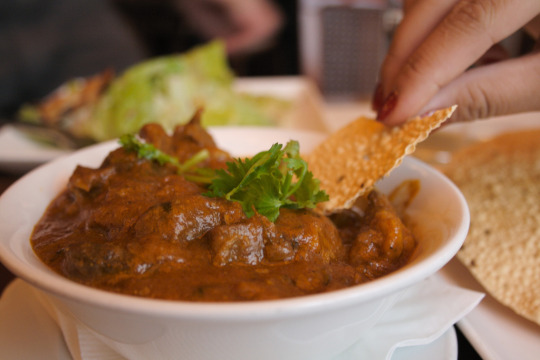
Rogan josh is an aromatic curried meat dish originating from Kashmir. It is made with red meat—traditionally mutton—and colored and flavored primarily by alkanet flower (or root) and Kashmiri chilies. It is one of the signature recipes of Kashmiri cuisine.
A number of origins/meanings of the name have been suggested, such as "stewed in ghee" or "red meat/red juice."
Its characteristic deep red color traditionally comes from dried flowers or root of Alkanna tinctoria (ratan jot) and from liberal amounts of dried, deseeded Kashmiri chilies (lal mirch).
Many modern interpretations of this dish add tomatoes to the sauce. This is especially common with ready-made pour-over cooking sauces to the point that Rogan josh is often described in the modern day as a tomato-based dish.
GORKHALI LAMB

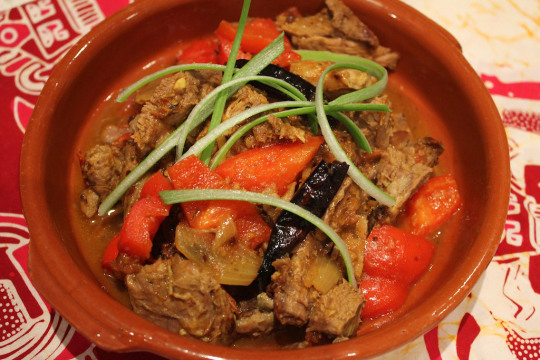
The word Gorkhali (गोर्खाली) is historically synonymous with "Nepali," so Gorkhali lamb could also be called Nepali lamb. The name change, from Gorkhali to Nepali, occurred in the 1930s.
(In the modern day, Gorkha is usually used to refer specifically to military units in the British or Indian army that were made up of men from the North Indian/Nepal region. Starting in 1816 the British East India Company frequently recruited these men as mercenaries, and over time the Gorkhas became very distinguished as exceptional soldiers.)
I couldn't find much about Gorkhali lamb aside from recipes, most of which just echoed the same information, and many of them didn't seem to come from very authentic sources.
From what I've been able to piece together, you make Gorkhali lamb by marinating lamb meat (usually meat on the bone) and cooking it over a charcoal grill. Once it's done, you coat the grilled lamb with a sauce made with chilies and tomatoes, and serve with rice or roti.
I'm not an expert, but it seems like Gorkhali lamb isn't a stew or a curry, it's a sort of marinated, grilled lamb with a sauce. If someone knows more about Gorkhali lamb, please let me know!
Like the Rogan Josh, the addition of tomatoes is a modern invention.
THUKPA
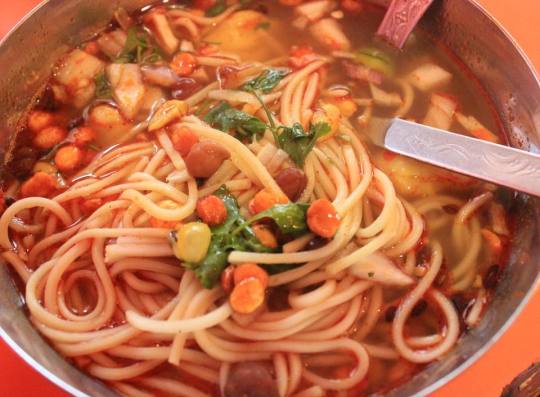
Thukpa is the Tibetan word for any soup or stew with noodles. Thukpa can be prepared in both vegetarian and non-vegetarian variations; the most popular non-vegetarian variation includes chicken, but it is sometimes made with mutton as well.
The Nepalese version of Thukpa is predominant vegetarian, and has a spicier flavor. The protein ingredients are replaced with vegetarian alternatives such as various types of bean.
However, non-vegetarian thukpa is also enjoyed in Nepal, and egg thukpa is probably the second most popular type.
Thukpa is made like most other noodle soups. Some modern recipes include tomatoes in the soup paste, most likely a modern addition.
INDIAN MUTTON CURRIES
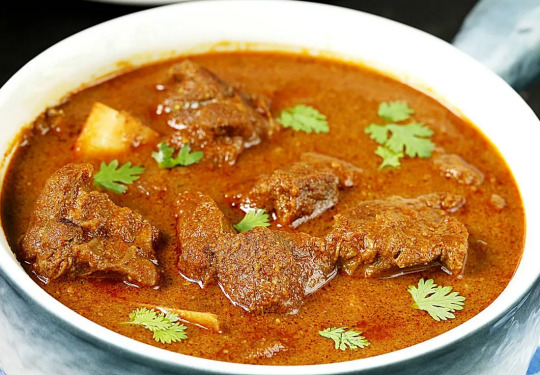
There's many different variations of mutton curry (Kosha mangsho, Mansa kasa, Tapelu, Rezala etc.) throughout the entire Indian subcontinent. Some recipes include tomato, some don't, and as with everything else in this post, the tomatos are a modern addition.
NEPALI MUTTON CURRY
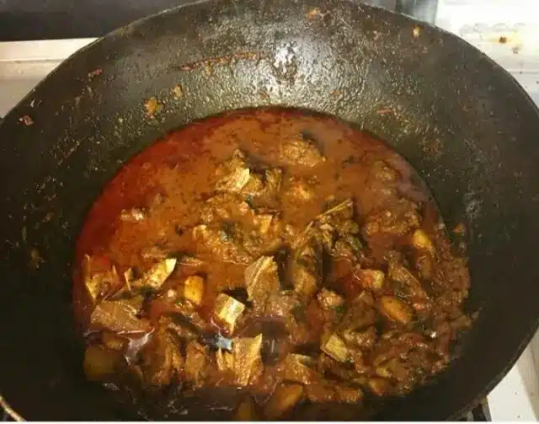
As I said before, mutton is incredibly popular in Nepal. It's reserved for special occasions and celebrations, like Dashain, Nepal's biggest festival. There are many different types of stew and curry in Nepal that feature mutton, and mutton is a popular meat to use in momos or fried rice as well.
SO WHAT IS KABRU'S GOAT STEW?
Unfortunately we still don't have enough information to give a definitive answer.
However, I would say that thukpa and Gorkhali lamb can both be ruled out, since noodles are the core of thukpa and Kabru doesn't mention that his stew is missing noodles. Meanwhile Gorkhali lamb doesn't seem to be a proper stew.
So then what we have left is Rogan josh, and Indian or Nepali mutton curries. Based on all the little tidbits we know, I'd be inclined to assume Kabru's stew is one of these Nepali curries, since they are so iconic of Nepali cuisine and are a big part of the local culture, and that seems to match what Kui tells us in the manga - that this food is a cherished childhood memory.
I've sprinkled some links throughout this post, but you can read more about Nepali mutton curry, and other Nepali food at all of these sites:
https://nepalicooking.tripod.com/lamb.htm
https://www.buzzfeed.com/anupkaphle/here-we-goat-again
https://www.buzzfeed.com/anupkaphle/keep-calm-and-curry-on
https://www.foodpleasureandhealth.com/nepali-style-goat-pakku/
MUSHROOM POSTSCRIPT: I have seen some people get confused by the goat stew page in the manga. They think that when Kabru says "my mother used to make this stew for me" he is talking about Milsiril, the elven woman who took care of him after his birth mother was killed.
Though we do not know 100% for certain, I think this is an objectively incorrect reading of the text. I may make a more comprehensive post about this another time, but:

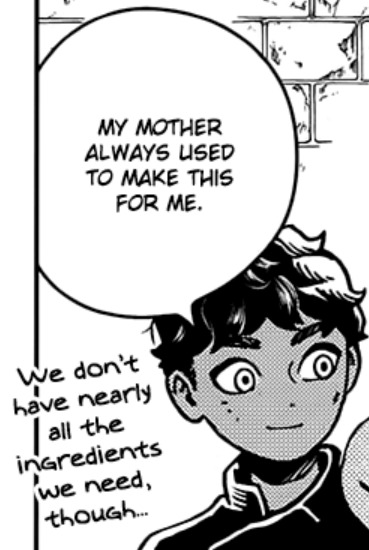

Kabru says he ate this stew as a child, that he hasn't had it in a long time, and that he's looking forward to having it again. He says he is relying on childhood memories in order to make the stew.
If this stew is something Milsiril made for him, why did she stop making it? Why hasn't Kabru had it in a long time? Was there a goat blight for the last 10 years? Did she stop making it to punish Kabru for wanting to leave her? This seems like important information Kui would have told us.
The much more logical assumption is that Kabru's birth mother, who died when he was 7, is the one that made lamb stew, and that's why Kabru hasn't had it in a long time, struggles to remember how to make it, and also why he's so excited to eat it.
This is in direct contrast with the elf fruit cake that Milsiril forced Kabru to eat as a child. Kabru's birth mother made him something he loves, that he is eager to eat again, while Milsiril forced him to eat elf cake so often that it has become his most disliked food.
Kabru and Ryoko Kui never refer to Milsiril as Kabru's mother, the phrase “foster parent” (養母 or 育ての親が, lit. meaning “parent who raised me” in contrast with a birth/blood parent) is used instead in both the manga itself and in the World Guide.
There are several other things like this (how Kabru talks about Milsiril) which I think makes it clear that Kabru probably doesn't call Milsiril mother willingly, and that he goes out of his way to put distance between her and himself. He doesn't hate her, but he doesn't want her to be a part of his life.
Milsiril is a wealthy noble in a society where women are equal to men. It's unlikely that she personally does much cooking, and even if she does cook as a hobby, it's unlikely that Kabru watched her butcher a goat - servants or the butcher would prepare the meat for her.
Milsiril is a fussy eater, and hates most foods. Goat tends to have a strong flavor and is sometimes gamey. I don't think she'd eat goat... Meanwhile, as I stated previously, goat is a delicacy in Nepal, so it would make perfect sense for goat to be a special treat Kabru grew up eating.
Yes, Milsiril sometimes does things she doesn't want to do because Kabru asks... But both examples we have of this, she tries to turn it into a punishment. She explicitly says she's training Kabru so that he'll give up, not because she wants him to get strong and succeed. She wants him to fail. She takes him to her family reunion to prove to Kabru that it's unpleasant, so he won't want to go again. Both times this tactic doesn't work, but she clearly states that this is her intent.
I could go on about this for hours, but this post is really about goat stew!!! But just wanted to throw that in there in case anybody is confused about who exactly cooked goat stew for Kabru.
As I said, there's always the possibility that I'm wrong, but I think the evidence is pretty overwhelming that when Kabru says "my mother cooked this for me" he isn't talking about Milsiril.
#dungeon meshi#delicious in dungeon#kabru#dunmeshi#talking mushroom#dungeon meshi research#kabru of utaya#kabru dungeon meshi#analysis#The Essay#Dungeon Meshi Research
33 notes
·
View notes
Text
Shannen's Native American Descent
We all know Shannen Doherty was of Irish descent through the paternal side of her family.
The Doherty / O’Doherty family is an Irish clan based in County Donegal. The O’Dohertys are named after Dochartach (c. 10th century), a member of the Cenél Conaill dynasty which in medieval Irish genealogy traced itself to Niall of the Nine Hostages. The O’Doherty clan and family name is one of the most ancient in Europe. The clan traces its pedigree through history, pre-history, and mythology to 2BC. (Source)

Shannen and her dad, John Thomas Doherty, in Ireland ca. 1996/97.
Shannen was also from English and Scottish descent through her mother Rosa Elizabeth née Wright. The red-haired Southern belle also has Native American ancestry, most concretley the Chumash people (Source), and thus has Shannen (Source).
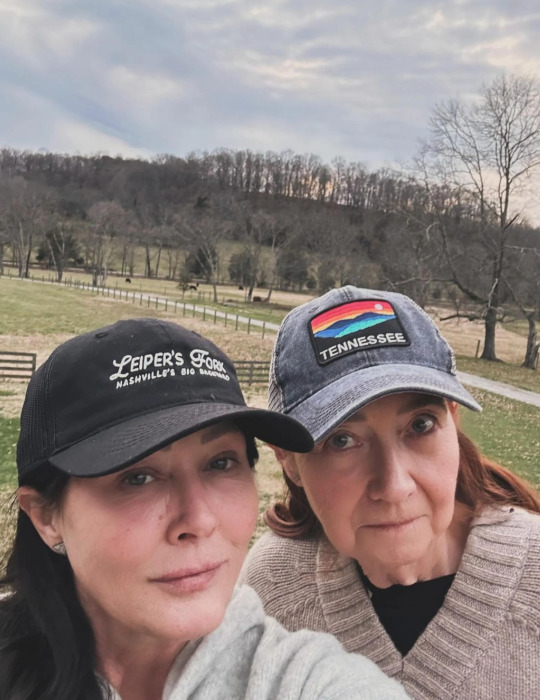
Shannen and her mum spending time in nature, ca.2024.
Shannen explained that she wasn't able to be with her dad when he passed away on the 4th of November of 2010. Her best friend Chris Cortazzo told her to spend some quality time with her mother and him at his ranch in Tennesse, which is surrounded by Native American ground. When she was there suddenly the wind shaked the plants and trees and she felt her father’s arms go around her and say “It’s ok baby, I love you. I’m here" (Source) (Source).
Her mother Rosa said that one of her great-great-grandmothers (she doesn't know the grade) was forced to move in the called "Trail of Tears", the forced displacement of approximately 60,000 people of the "Five Civilized Tribes" [Cherokee, Chickasaw, Choctaw, Muscogee (Creek), and Seminoles] between 1830 and 1850, and the additional thousands of Native Americans within that were ethnically cleansed by the United States government (Wiki). Furthermore, she said her ancestor was from the Chumash people and was forced to move from Mississipi to Oklahoma (Source).
Rosa also said about Shannen's Native American's heritage:
"The whole Indian heritage to Shannen was very, very important ... Shannen swore when she bought this property [a ranch in Malibu to live with her mum, her friends, and to do a shelter for horses]… she says, I just feel it. She says, I know that this is where I'm supposed to be. And she just felt that whole Indian."
Also she was proud of having directed "Charmed"'s episode "The Good, The Bad and The Cursed" that features a storyline involving American's First Nations people's and Native actors Kimberly Guerrero (from Colville and Salish-Kootenai native peoples from Alaska) and Michael Greyeyes (Nêhiyaw (Plains Cree) from Muskeg Lake Cree Nation in Saskatchewan, Canada).
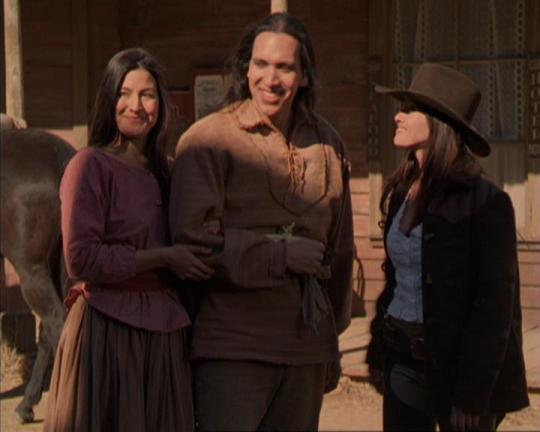
Shannen Doherty (R) with First Nations' actors Kimberley Guerrero and Michael Greyeyes.
The Chumash are a Native American people of the central and southern coastal regions of California (Wiki), in portions of what is now Kern, San Luis Obispo, Santa Barbara, Ventura and Los Angeles counties, extending from Morro Bay in the north to Malibu in the south to Mt Pinos in the east. Their territory includes three of the Channel Islands: Santa Cruz, Santa Rosa, and San Miguel; the smaller island of Anacapa was likely inhabited seasonally due to the lack of a consistent water source.
Modern place names with Chumash origins include Malibu, Nipomo, Lompoc, Ojai, Pismo Beach, Point Mugu, Port Hueneme, Piru, Lake Castaic, Saticoy, Simi Valley and Somis. Archaeological research demonstrates that the Chumash people have deep roots in the Santa Barbara Channel area and lived along the southern California coast for millennia.
The Chumash lived in over 150 independent villages, speaking variations of the same language. Much of their culture consisted of basketry, bead manufacturing and trading, cuisine of local abalone and clam, herbalism which consisted of using local herbs to produce teas and medical reliefs, rock art, and the scorpion tree. The scorpion tree was significant to the Chumash as shown in its arborglyph: a carving depicting a six-legged creature with a headdress including a crown and two spheres. The shamans participated in the carving which was used in observations of the stars and in part of the Chumash calendar. The Chumash resided between the Santa Ynez Mountains and the California coasts where a bounty of resources could be found. The tribe lived in an area of three environments: the interior, the coast, and the Northern Channel Islands. Some researchers believe that the Chumash may have been visited by Polynesians between AD 400 and 800, nearly 1,000 years before Christopher Columbus reached the Americas.

Chumash Family by American sculptor George S. Stuart
The maritime explorer Juan Cabrillo was the first European to make contact with the coastal Alta Californian tribes in the year 1542. Spain claimed what is now California from that time forward, but did not return to settle until 1769, when the first Spanish soldiers and missionaries arrived with the double purpose of Christianizing the Native Americans and facilitating Spanish colonization. The Chumash people moved from their villages to the Franciscan missions between 1772 and 1817.
Mexico seized control of the missions in 1834. Tribespeople either fled into the interior, attempted farming for themselves and were driven off the land, or were enslaved by the new administrators. After 1849 most Chumash land was lost due to theft by Americans and a declining population, due to the effects of violence and disease. The remaining Chumash began to lose their cohesive identity. In 1855, a small piece of land (120 acres) was set aside for just over 100 remaining Chumash Indians near Santa Ynez mission. This land ultimately became the only Chumash reservation, although Chumash individuals and families also continued to live throughout their former territory in southern California.
No native Chumash speak their own language since Mary Yee, the last Barbareño speaker, died in 1965. Today, the Chumash are estimated to have a population of 5,000 members.

Map of the Trail of Tears
Chumash worldview is centered on the belief "that considers all things to be, in varying measure, alive, intelligent, dangerous, and sacred." "They assume that the universe with its three, or in some versions five, layers has always been here."
Human beings occupy the Middle Region, which rests upon two giant snakes. Chronological time is unimportant, though the past is divided into two sections: the universal flood that caused the First People to become the natural world and, thereafter the creation of human beings, the arrival of the Europeans, and the devastating consequences that followed."
The middle region (sometimes referred to as 'antap), where humans and spirits of this world live and where shamans could travel in vision quests, is interconnected with the lower world (C'oyinahsup) through the springs and marsh areas and is connected to the upper world through the mountains. In the lower world live snakes, frogs, salamanders. The world trembles or has earthquakes when the snakes which support the world writhe.
Water creatures are also in contact with the powers of the lower world and "were often depicted in rock art perhaps to bring more water to the Chumash or to appease underworld spirits' at times of hunger or disease." Itiashap is the home of the First People. Alapay is the upper world in Chumash cosmology where the "sky people" lived, who play an important role in the health of the people. Principle figures of the sky world include the Sun, the Moon, Lizard, Sky Coyote, and Eagle. The Sun is the source of life and is also "a source of disease and death." The Sky Coyote, also known as the Great Coyote of the Sky or Shnilemun, is considered to be a protector and according to Inseño Chumash lore, “looks out for the welfare of all in the world below him”. During the creation of mankind, the Sky Coyote was present among the other important cosmological figures. The Eagle, also known as Slo’w, is the force that maintains momentum and order among the other stars so that they do not fall down on and destroy earth.
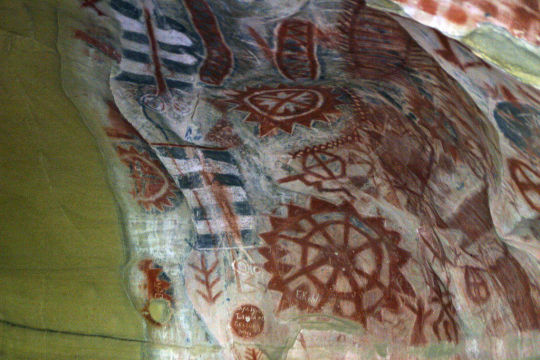
Chumash pictographs.
The Chumash cosmology is also centered around astronomy. Rock art and arborglyphs that have been found within Chumash sites are thought to have depicted Polaris (the North Star) and Ursa Major (the Big Dipper). These two astrological entities were paramount to the Chumash belief system as well as their perception of time. It is believed that the Chumash used these constellations to determine what time of the year it was depending on the position of Ursa Major around Polaris.
***
I love that Shannen showed her respect to her ancestry in some "Charmed" episodes, like in 2x10 "Heartbreak City" (click to see if bigger):

Charmed 3x01 "The Honeymoon is Over" (click to see bigger):

And the already mentioned 3x14 "The Good, The Bad and The Cursed" (click to see bigger). Her love for horses also comes from that connection:

#shannen doherty#ancestry#irish ancestry#native american ancestry#first nations ancestry#chumash#chumash people#family#trail of tears#heritage#indian heritage#charmed 3x14#charmed 2x10#charmed 3x01#charmed#director#shannen doherty director#shannen director#1990s shannen doherty#2000s shannen doherty#2020s shannen doherty#rosa doherty#malibu#chris cortazzo#tennesse
20 notes
·
View notes
Note
How do the demons react/interact with a human GN reader? Do they like foreigners? I feel like they might be racist? Does douma think of like foreign meat lol? Reader can speak Japanese so I guess they can talk if you want them to interact?
Also I love your righting! I think you are the only king writer who writes them in character, it’s so nice reading fanfic when the characters are writing well and you are the only person who writes them right, plus you write really well! Great detail! I always look forward to your writing!!!
*In History Channel II voiceover* After the American colonization by the Europeans, the Japanese folk started to distrust foreigner forces to not cause distubances in their recent adquired piece by pressing their influence, leading them to close the borders in the Edo period. It wasn't until- *static sound before it takes over the post*
Also, Douma reacting to western meat is gold, imagine if people tasted similar to their local cuisine. Bet that would make Chinese, Indian (from India, to make sure it's clear. I never refer to natives of America, as a continet, as Indians), Mexican, and Korean people his favorites (he strikes me as someone that loves spicy food, one of those who always say "It's not that spicy" while blushing and sweating).

Demons meeting foreigner Human GN Reader
Warnings: Cannibalism, Racism, Mentioned prostitution, Mentioned sexism, Mentioned/Implied reader's death (bonus dead reader), And Deshumanization? (Some of the demons get refered as "it", so does reader).

Gyutaro + Daki:
Now, let's be clear, after the borders got open again one of the places that got the most amount of foreigners was the Red Light District. Obviously, only wealthy people came, hence they went to take some entertainment while making deals and trade, besides the Japanese upper class using the attractions as a displey of power and superiority. Now, to say Gyutaro and Daki are fond of these... turists... they are not.
It's mostly mild annoyance of things that build up, like their attutide to degrade the courtesans to just serve food, drinks and sex, the dislike of their accent and disregard of errors when speaking the language, the fact they speak of the courtesans in between them in their native language, a lack of proper manner or knowledge to behave in the tables, and everything. Daki still remembers the time on threw a poem she wrote with exquisite caligrafy. It's not pleasurable, but they rarely appear, so it can be tolerated. In some senses they are not worst than first time clients, or the poorest who are expending everything in one night of entertaining, but still.
"Excuse me." It was pure coincidence you met them, you only wanted to ask for the bill of the drinks of the woman attending you, wanting to leave as the bussiness trip was taking a turn out of your comfort zone. When you entered, you found a half-naked woman using sashes to absorbe the one who was attending you. You tried ran from it by miracle, scaping to the crowd. You tray to tell it to someone, but you just were discarted as drunk because due not being your first language, the fear, and the adrenaline of the scape anyone couldn't understand your Japanese. It was the second, the mere second you weren't watched that you felt a presence, a cold breeze of air and preassure that left you dizzy, that you suddenly found yourself back inside, in a dark room.
"I got --- -----, neheh." The voice sound so distorted you can't understand it, it feels that half of what he, you think, says are sick groans and moans of pain that slur words. When you look at the source of the voice you see a... is that even human? And the woman from before, tone more childish, but at least you can understand what she says. "Not pretty enough for me, clearly not a Japanese beauty. It might make me sick! I don't want to eat that! And I don't want you to eat it neither!" They both look at you, as you tremble, not knowing what to do. "Ne. You seem to be very lucky, ne. Good for you! None of use seems interested in eating you, so you get a quick death. Ne!" It.... he says, talking slowly, as he brings his arm up and blood starts to cone out of wrtist into his raised hand in the shape of sickle. You finally find your voice, talking in panic, as you beg in your native tongue. "Hey! We don't speak... whatever you are talking! Shut up! If you are going to cry at least do it in Japanese!"
They seem annoyed, and you don't know if you might manage to raise their volume so someone might come and see before they kill you, but you try to regain composture and talk in Japanese. Talk in Japanese, Y/N. "Please, I'll do anything. Let me go.... " You beg, in that you start to mention your family, your home, fuck you don't want to die so far from home, rambling in desperation things about your culture, traditions, your favorite places while thinking that you don't want to die without that in a place your loved ones won't be able to mourn you and by the time you realize... the female.... one is actually interested.
"What does that mean?" She seems curious... in a childlike way, which would be endearing if you didn't fear for your life. The other one seems to relax and let you both be. You don't understand, but you also dom't ask, just... satiate her curiosity, not fully so she won't decide she had enough of you, yet enough to give her something worthwhile. Aurprinsinly enough, they let you go when the sun comes out, or rather, they dissapear in a rush. You take your chance to leave, not without hearing a whisper in your ear. "You better come back tommorrow night, ne." You can only tremble.
Gyokko:
Gyokko can't stand good people on a good day, now imagine him tolerating turist in a normal one. He was just stealing viewing some foreign goods that just came in a ship, some more interesting than others, when you, who probably traveled in that same ship, walked on him. You freeze the second yoy lay eyes on him, clearly anything but a human being, mouthes where the eyes should be, pale scales instead of skin, no legs as the bottom is linked to a pot, an eye on the mouth and one on the forehead. You can only stare in confusion and fear, and after a few seconds of silence, Gyokko talk. "What are you-" "AAAHHHHHHHH!" You run, as if hearing.... it talk was the last straw, what you needed for your body to activate a fight or flight response.
"You little shit!" You try to get towards the exit when you get yourself tripped with abother pot... what that.... that wasn't there earlier, was it? You don't get an asnwer, instead you see that creature getting out of this new pot, slowly and smoothly, as if it lacked bones. You are terrified, what ia this thing? "Don't run away when I'm talking! You foreigners are animals or what?! You lack any basic esucation and respect to the ones that are older!" It talks so humanly, in the same tongue of the people native to these lands, one mouth speaking at the time.
It takes you a while to be able to regain the courage to speak, even more to remember how to do so in Japanese. "What are you?" You manage to ask, you think, fluently enough. Or maybe you didn't, because now it's your turn to be stared by those creepy eyes. You get the term "oni" or something like that, but you have no idea what it means. It's a monster? A ghost? A demon? Maybe asking, considering the bridge due the language, was useless, and it embarrasses you, but now your attention is more in how to get away from this "oni". "I... I need to go. Have an appointment." That is all you can try.
Gyokko looks at you, and decides to wonder. How would your skin taste? Would it be a delicasy? Or would he loath it as much as he is loathing your manners and personality. "An appointment, you say?" Or maybe, just maybe, he can take advantage of this. If one of his pots, or several, manage to reach outside Japan, he might be able to do so as well. (Not that he knows, he might not have enough power for such a trip, but a little testing would never hurt). "Then let me apologize for keeping you here." He makes a new pot out of one of his hands before offering it to you, you don't dare to deny it... maybe it's friendly. "I might give you more if we meet again, hehehe~" and like that, Gyokko leaves, wanting to see if he can get out of Japan, to conquer forward would definetely please him. And you... you can only keep the pot in your bag and never break it or take it out. Never.
Hantengu + Clones:
Hantengu is afraid of the seas, and anything that comes from it. Some fishes, waves, even people! How can people come from the sea?! Do they breath in water?! Are they monsters?! So scary! So scary! No! No! No! It's so scary he would never steal from any of those ships! Never! It's his hands! It's his hands fault! Have some compasion towards an old, blind man! Yes! He is blind! Please don't "EEEEEEEECK!" A scream, or rather a shriek, leaves his lips once you go to get your stuff. You have no idea what is hoing on, you just cover your ears under the assault on them. Meanwhile Hantengu is just. So. Scared! So he decides to take actions.
He runs. And you just look confused, precessing what just happened. Some seconds of silence and you decide that all of that was just your imagination and you must get to the inn to sleep it off. You didn't expect is to hear a different voice, angry, from the direction Hantengu ran off. "What?! This is it? This is what we were summoned for?!" Only to find completely different figures, ascept they are not. 4 horned "humans" with bright eyes, exactly the same from one another. Escept one that has... bird limbs? Talons in his hands, feet and wings... what is- "Now, now, Sekido! Be nice! Aren't you glad we got separated?" A different voice, even if it's just the same face, except the eye color. "It's pathetic how much Hantengu has come to rely on us, so sad. This is just a mere human, one of us is enough. Why call the four of us? Really sad."
Then one of them is suddenly on top of you, the bird one, making you fall on your back as he kneels on top of you to see you in the face, closer. He has fangs... and... kanji in the eyes. "This one is different, though. I can already taste it!" What the-? "Kill it! Kill it! It's a monster! It comes from the sea!" The figure from before, except it's so small. What happened to it? Him? You don't even know that. But most of the figures just stare at it, either looking done for or confused, as the one with red eyes talks again. "What? This human? You have to be fucking with us! You got scared because of a foreigner?! You yourself can kill that shits! We should, before they infest the proper culture!"
"Oi, oi, Sekido. Isn't that a bit too harsh? To kill them inmediately would be a waste. We could at least check out if it's actually different from a, ya know, normal human. From Japan. Don't ya agree, Urogi? Aizetsu?" "A human it's a human, they are weak and die, it's sad no matter what. I don't see why put so much effort." "Well, I DO want to know how is life outside Japan!" They are all basically talking over you, and you try to push the bird figure off you, but it's a lot heavier than you expected it. Aren't birds supposed to be light to fly? "Hey human! Can you breath underwater? Can you eat fish? Oh! Oh! Can you read and write?" "You yourself don't know how to read and write Urogi." You feel crowded, but at least none of these seem to be that aggressive, except the red-eyed one, but that one seems busy with the green-eyed one.
"I would like to sit down....." At least the bird onw gets off you, even if he keeps assaulting you with questions. You answer as much as you can when you hear a shout from the other side. "Fine! But it's your responsibility, and you will get rit of them when you are done, AND deal with the main body! Understand Karaku?" There is a nod as the green-eyes one takes the small figure near the group you are with. "Good news! Ya get to live until we get bored! I reccomend you to be interest, beside, Hantengu needs to you you are just a human." He shows the sobbing creature in his hands. "Oh! Do we get to name them?" "Humans come with names most of the time, Urogi. So no."
So, two want to know about you, one wants to get rid of you, one doesn't care and the first figure is scared of your. Just what the hell is hoing on? "Y/N. My name is Y/N." The bird one deflates, but the geem-eyed one grins. "A pleasure to meet ya! Name is Karaku, and I bet we will have a lot of fun together!" You don't like how he said "fun", but you don't get much of a choice. So you play along, and wait for a chance to just run away. And you get it an hour or two the sun comes out, as the crowd starts to form. You must just have to wait for the right moment. Just wait.
Nakime:
So far, you don't regret coming to Japan, you have seen things you liked, things you disliked, and managed to try new things. It was an experience alright, not one to do so many often, considering what a nuisance it was to arrive to Japan in the first place, and you still would not abandon the comforts of home for nothing. After all, such a travel would not be possible for anyone with low resources, and you are more than happy to be able to make a travel or two for luxury every once in a while, but soon it will have to end. Not that you can't make the best of it while you are at it, that is why you are moving with some strangers as they guide you through the city, just now they showed you a very nice restaurant, where you ate and ate and made your money worth. You were about to part ways when suddenly a note of a weird instrument sounds and... you are in free fall.
Nakime doesn't deal with people. She is too important for him to remain unhidden, or at least that is what she tells herself. The only humans that step into her castle are the ones she, and any other guest (namely Muzan), will be dining for the evening. Your odds were not good when uou found yourself in a place with no ceiling, floor and wall at the same time it has millions of them, changing passages and corridors, portal doors and everything that can make a house a fantasy puzzle. And she is weirded out as you fall into a room nearby her, as the group you were with are spreaded across the castle, as she hears some weird words she has never heard before, clearly not japanese.
She looks at you with curiosity as you finish to swear due the pain of the impact, but with how long you have been falling, you guess it's a miracle you are still alive. And... what is this place? What... you can't begin to describe everything and everywhere... moving. Floating. Existing. You can't even see from where you fell, and you swore you heard the other scream as well, when a female voice makes you turn around. "Is there something you want to say outloud?" Pale skin, black hair covering her eyes, black dress, or kimono, or whatever it's called. That is all you can tell from the distance, besides the fact she has a... a guitar, you think? "Where are we?" You feel the need to ask her.
She doesn't recognize your accent. "You are not from Japan, are you?" Now, should that knowledge even change things? Should she reserve you for him? Should she just kill you and eat you? She definetely can't send you back, not that she would. But this is a new experience that might need s new resolve, and she isn't sure how she feels about it. Better to bother him more than actually needed than to do something wrong. "My name is Nakime, and you shall stay here until I can reach my master." She says as she plays her Biwa and you are... in a room, no doors, no windows, only a room, until your fate is sealed. You should have stayed at home.
Akaza:
Akaza will not admit it but... he actually forgot for the longest time there was a literal world outside Japan. Truth be told, Japan is already big enough as it is, and with his speed he has already traveled throght most of it, if not all of it with the smaller islands around being the exception. After seeing so much... repeatedly, in search for a god dammed flower, he just... forgot there is more. His life, as far as he remembers, was confided in his duty and how far his abilities would let him go, sothe second he realizes there is actually people from... outside, he gets curious. Not particulary fond, but curious.
Finding you was a coincidence, thought. And one that was not that probable to happen. He was looking for the blue spider lily, and you were just having a walk nearby the inn. And what you see is a man with weird eyes, weird hair and weird tattoos. It does startle you at first, but is human enough, even if the lack of clothes and the light coming from the eyes, says otherwise. Maybe is some coatume due a tradition, it wouldn't be the weirdest one you have seen so far in Japan. "Hello. Are you also traveling?" Akaza can tell by your smell alone, even without getting close. You are not from here, you came from the sea, it's smell still lingers on you, alongside with a scent of... unknown. Not only that, but you are so out of place you don't realize the danger you are in.
At first he is tempted to threaten you, to tell you to fuck off, basically. Akaza is not really hubgry right now and he would rather not spoil his night by having to deal with a weak human. But... when was the last time he was able to hold a converdation with a human? He remembers a hashira, years ago, one he killed after being rejected, while they were fighting. Come to think about it, the only humans he actually talks to are Hashira, so... why not make a little change just for once. It's not like he will ever see ypu again, specially after you leave Japan. "More or less, I'm Akaza. What is your name?" You at first have trouble understanding, since you use the polite tones, the ones you were taught to use, while this guy, Akaza uses a less formal one.
"Y/N." Is all you can say as you see him smile, it would be charming if it wasn't in a "I know something you don't" way. "A pleasure. I never heard that name before? Where is it from? What does it mean?" Akaza decides to just be curious, he can't get in trouble for making a few questions and not eating you. And a part of him is... happy, very relaxed, to be able to sit down and talk without any threats or status in between. There is something... nostalgic about it, but he can't put his finger on why. "I hope you don't mind if I stay with you for the night. I would like to hear about yourself." Specially since... he seems to know how to keep a conversation alive? Odd. Just odd. Meanwhile, you decide talking with a handsome stranger is not the worst thing this trip could give you. "Of course. What do you want to hear about?"
Douma:
Douma rarely ever gets to even hear about foreigners, being in a secluded cult tends to leave him a bit out of touch from society, with the exception of the few times he goes to have a walk, burn some steam, outside at night. But even then, he isn't there for light conversation, which leads to the fact that he is definetely excited to meet you, if his accelerated heartbeat is meant to say anything. You found his cult by mere coinsidence and, while you don't believe in a man being able to hear the gods (you don't even believe there are "gods", but you are not here to tell other why their religion is wrong) but you were curious about this talk of "silver hair and rainbow eyes", specially since there was a chance you didn't understand correctly because of the language.
But he does have rainbow eyes and silver hair, almost like a mytical creature. Very attractive, but still very human in his appereance, even if there is something odd. Then again, to you, every Japanese has been odd, almost completely different to how people work back home. "Why don't you spend the night here? I would love to talk with you a little more. I find myself intrigued with what else is unique about you." He offers, making you conflicted, something about him makes want to both come closer and run away. You end up going back, you already booked an inn, and you don't want the money you spend on the room and food to go to waste.
The walk is long, even by carriage or horse, it's doesn't help when suddenly the wheel broke. You were waiting for reparations when suddenly you saw something shine in the dark. When you got clored, you were suddenly pinned on the wall with your mouth covered by a cold hand, as if it just touched snow. Just like the hand of... that man, that is looking at you. There is no way he is actually anything but a human, right? But how did he get here? Alone? At night? Those were 3 hours in carriage. "Y/N? Right? I am afraid I couldn't control myself, I was just so curious. I have never had the chance to taste a human from overseas! I needed to try you out!" He says cheerfully. What does this freak mean? You don't understand at all! What does he want with you?
"Oh, don't do that. You will not be able to scape my grip, no matter how much you wiggle. Specially since I would like to talk with you, so it would make me very sad if you forced me to kill you so soon. I would even cry!" You stop in your tracks, kill you? Then you realize the guys is not even putting an effort at all, just smiling at you expectantly. Then, suddenly your mouth is free, but you are too afraid to shout for help. What is this? A demon? Like, a demon from hell? "Don't be afraid, you will see that you end up winning on the end, you will be able to exist forever within me." Just what did you get yourself into?
Kokushibou:
He is aware, of course, that there are... people, outside Japan. He remembers his father buying every once over half-a-decade an item from foreigner merchants. "Exotic tokens", he called them. Michikatsu knew better, his father didn't like those pieces of... trash any more than he did, it was just a display of wealth for when visitors came. Still, it was never of his liking, and now that he is meeting you... it's not that he is conflicted, it's that he knows that what he is thinking shouldn't be said put loud. You are... different, to say it kindly, non-traditional, and he is not fond of that.
You can't hold yourself to the same standards he always held himself, or tried to, the ones of a proper man of the samurai gentry, since your education is completely different, if you even have that. The lack of knowledge in your culture doesn't let him tell just with your clothes or manners. He doesn't know what irritates him the most, his loss when trying to read you or how different you are. It's odd, out of his comfort zone. Kokushibou hates being out of his comfort zone. It doesn't help that you are outside your comfort zone too, having troubles with the culture and language.
You just found each other a moment you walked out the inn for fresh air. The first thing you did was scream, he flinched. The second thing you did was run, he stared, inmovilized in the spot you just saw him, wondering if you are worth killing or not. Then he figures out... you might not be versed enough in Japanese for you to say anything, and people might just tell you you saw a ghost (not that he can say if they are real or not), so... it's not worth the effort. Then an intrusive thought flies through his brain.
"What if he ate you?" A part he always denies prompts in, that part that is less a samurai and more an animal than anything else, always hungry, angry, envious and greedy. And it does have a point this time, he might never get a chance to taste something different, to pretend he has some choice in what he eats, if he doesn't do it now. Is tempting, as you run away. A jump with few steps would be enough to catch up with you, or not even that, a swing of his swords with a breath would be enough to kill you as you run, slicing your body as you move. Kokushibou stays still for some seconds, heart beating fast as he contemplates, grip tight on his sword, takes a deep breath... and turns around to never see you again as long as he can do something about it. For the better for both of you.
Bonus:
Douma's hunger is being now placated by your flesh, wet sounds of the blood and tissues splashing as he rips the pieces, instead of just biting them off your dead body. He doesn't remember the taste of sticky rice in a human tongue, but if he had to describe the new taste in comparison with "not sticky rice". He can't seem to explain, the amounts of greese, iron and other tastes are just different. But he likes it. It's new, and that makes it exciting, addictive even. Part of him regrets killing you so soon, an unrealistic part of him wishes this taste could have been prolonged somehow, but not finishing to eat you now would only be a waste.
The sound of the fangs penetrating your skin, and he wonders, do all foreigners taste like this, or just you. He really, really, really wants to find out. What would it take to have him to agree to invade some neighbor country, he wonders. His heart gets giddy at the thought. More food om the way! He definetely has to try to ask. With that in mind, he finishes to eat, and the next time there is a meeting between the Kizuki, he will ask permission to start a movement to have more foreign meat. He drools at the idea, it's impossible he will be said not to.
[Spoiler: Muzan did say no. Douma is disappointed.]
#demon slayer#kny#upper moons#karaku#urogi#aizetsu#sekido#gyutaro#gyokko#hantengu#daki#nakime#akaza#douma#kokushibou
44 notes
·
View notes
Text
Penang is well-known for its vibrant Straits Chinese Peranakan culture, but if you know where to look, there’s another chapter to its history. While the focus is often on the marriage between overseas Chinese traders marrying local Malay women, the truth is, the Chinese were not the only traders conducting business in George Town. Merchants from around the region were familiar with Penang, having already flowed through Penang on various trading missions.
Between the 10th and 18th centuries, traders and migrants from India, Persia, and the Middle East arrived in Penang. Their marriages with local Malay women gave rise to a new branch of the Peranakans, known as Jawi Peranakan, with Jawi denoting Southeast Asian Muslims, and Peranakan taking its meaning from the Malay word ‘anak’, or child. Over time, this group expanded to include those who had Arab-Malay ancestry. In Penang, they were also once known as Jawi Pekan.
The Jawi Peranakan cuisine, much like its Chinese cousins, draws on cultural exchanges between Malay cuisine and its Indian, Arab, and Persian influences. Jawi Peranakan dishes tend to feature ingredients from India and the Middle East, including ground almonds and cashews, saffron, and rosewater. The cuisine of the Jawi Peranakan was generally recognized to be more lavish, and was often served during feasts and special occasions.
To get a taste of this chapter of Peranakan history, visit Jawi House, located on Armenian Street in the heart of George Town’s downtown heritage district. The house was recently renovated in 2012 according to UNESCO World Heritage Guidelines, but it has existed for six generations. It was established by the Karim family of Punjabi-Jawi Peranakan history, and today functions as not just a restaurant showcasing a modern take on Jawi Peranakan cuisine, but also as a small gallery charting the family’s history as well as classic handcrafted art.
Helmed by Chef Nurilkarim Razha, a descendant of the Karim family, the restaurant offers up iconic Jawi Peranakan fare. Popular dishes include lamb bamieh, a fragrant, aromatic Persian-inspired okra and tomato-based lamb stew; serabai, a Malay kuih which resembles a tangy, spongier pancake made from fermented rice batter and served with caramel kaya (coconut jam); and nasi lemuni, an herbaceous rich rice dish cooked with butterfly pea flowers and the herb Vitex trifolia.
21 notes
·
View notes
Text
good god girl, maybe some of us are not vegan because we eat chicken like once in three months?? Would reduction not be a more productive goal of vegan activism than outright banning? Like if your arguments are that animals are being eaten, then you’re being unrealistic about the entire actual concept of the food chain. Humans are omnivores, you do not need to change that to achieve your goals.
A vegan lifestyle is also entirely the product of your geographical location. If you live somewhere that shit does not grow, what are you going to do?? I just think about the difference between food options in India and Canada, for example. India: between the tropics (tropics and equator even, in fact). All-year-round sun, there’s pretty much always stuff growing. Different kinds of land will mean you can grow everything from staples like rice and wheat to vegetables, fruits and plantation crops. It’s reflected in the cuisines: Indian food has a much, much wider offering of vegetarian food, and many more Indians have restricted diets that more or less overlap with vegetarianism. Because crops grows. Locally.
Canada. Harvest in the fall, from November to March, your fields are practically unusable. Compare the prices of fresh produce in (and now I’m being generous to give you a highly populated, non-remote province here for an example) Ontario. Ontario has farms where in the fall you get fresh autumn vegetables and fruits. You’ll also get them in larger quantities. It is way cheaper, fresher and also uses less energy and fuel to transport the vegetables like 50 km from farm to market.
Come the winter and nothing grows. If you look at most vegetables you’ll find on store shelves in December or February, and most of it is either imported from warmer regions of the US (often the case for chains that are in both countries) or from South American countries (sometimes SA -> USA -> Canada). The importing has to go through cross-country customs, had to be driven for days, is less fresh or rich in nutrients by the time you get it, and is more expensive. Of course. And we all come out of it poorer. Is it any wonder why people will eat meat? We’re even talking here about a place like Ontario, very well connected on North American trade routes. Can you justify someone in Yukon deciding to eat meat over a $17/lb. green veg? Be for fucking real…
There simply cannot be a blanket-global solution to animal products. You’ve got to work with what your geography has to offer. It’s the same thing we say when we say that avocados have an environmental cost when you expect them to be available year-round in places they don’t grow. We encourage people to go for more local produce there, and I think the same should go for all parts of your diet too. If your animals are local, then their footprint is lower than importing kiwis from New Zealand to the US. I don’t see how that’s hard to understand.
#veganism#the first para is a rant bc someone was being an idiot but I mean the rest of it most sincerely:#YOU HAVE TO WORK WITH YOUR GEOGRAPHY#capitalism has you thinking the whole world Is this flat homogenous thing#and all things can be solved by ‘buying (new solution)!’ *Buy!* our new Vegan Leather and feel good about yourself!#(<- plastic that will end up in a dump as Indonesia’s problem; not the pontificating American vegan’s)#*~Buy!!~* our new honey substitute! 100% cruelty free by avoiding the bees; even as the bees literally continue to make honey anyway#(<- monocrop agave fields in Mexico can deal with your misplaced guilt for you 🥰💕)#Like. At least have the courage of your convictions and quit sweetener entirely if you’re#concerned about both cruelty (which honey harvesting is not but okay) and sustainability. Or switch back to sugarcane.#Unless of course sustainability is simply someone else’s problem 😊 (hi third world!!)#My problems with veganism the movement are also my problems with the west; you all are really fucking hypocrites.#We have to go cleaning up after you guys all the time. You HAVE to work WITH your geography; not against it#Plants are not some miraculous catch-all solution. And mate; you’ve got to kill a plant to eat it too#Plants are alive; trust me. If you don’t eat anything for fear of killing it you’ll either be living on roadkill and infect and die#or you’ll end up killing yourself out of not! eating!#; you can’t eat rocks. All food was once alive.
7 notes
·
View notes
Text
Good Places To Eat For Breakfast In Nairobi | Butter Buns Nairobi
Nairobi Street Kitchen offers a taste of Kenya's unique flavours. Immerse yourself in a Good Authentic Mexican Food In Nairobi experience as we introduce you to the real flavours and fragrances of Nairobi's thriving street food industry.
#Events In Nairobi This Weekend#Indian Street Restaurant In Nairobi#New Brunch Places In Nairobi#New Breakfast Place In Nairobi#Happy Hour Nairobi#Local Mexican Cuisine In Nairobi#Upcoming Events In Nairobi#Places To Go For Dinner In Nairobi#Social Restaurant Nairobi#Butter Buns Nairobi
0 notes
Note
we do have actual restaraunts and by and large theyre run by immigrants who came here and opened a restraunt. that doesnt matter though i'm here to complain about MILD, MEDIUM, AND HOT SPICE LEVELS. at the indian place in my hometown (excellent restraunt) this is a REASONABLE SCALE. it MEANS SOMETHING. at the taco place where i go to college, and also at aldi's when i buy salsa, it apparently means NOTHING. mild salsa is NOTHING. medium salsa is SPICELESS??? there is allegedly some spice in there or it wouldn't be called medium but i have yet to find it. and hot is i guess your only hope for any spice flavor at all so better hope hot is edible to you! whereas at my beloved indian restraunt mild is a bit spicy (you can taste the spice), medium is quite spicy (this is what my mom and i get), and hot is presumably india-hot but i don't know bc we stick with medium. apparently my beloved indian place is not the norm and this appalls me.
anyway. american restraunts, if they're not fast food chains (and while there are differences it's not meaningful enough to matter; mcdonalds fries are like skinnier or whatever idfc) and they're not an ethnic cuisine which usually only shows up in towns/cities big enough to support them (and therefore less common in areas that are less likely to be interested or trusting of foreign food), and they're not the occasional local american food place (like grill or whatever, but those are also usually chains like texas roadhouse or chilli's - we really don't tend to have american food restraunts. like there's one in my hometown but they're literally famous for Existing and have a cookbook even though theyre not that good) are like. diners. diners are the only non-chain american food place that i feel like consistently can be found in most places. and that's a diner. it serves diner food. and more steaks and hamburgers
shoutout to every single halal cart i've ever eaten at also. bangers forever
nodding thoughtfully. see if americans were diehard burger samurai over their local diners it'd make more sense to me. like that's respectable. i'd also be a burger smaurai if i lived near a cool diner
81 notes
·
View notes
Text
Last Monday of the Week 2023-10-16
Another year older. Stealing the Untitled Wednesday Library Series format from Morrak for an open Reading section and then we'll get to the normal post.
Reading:
Untitled Monday Wednesday Library Entry No. 0
Do you like a recipe book? Do you like an unbearably comprehensive and frequently incorrect recipe book? Well boy do I have an item for you:

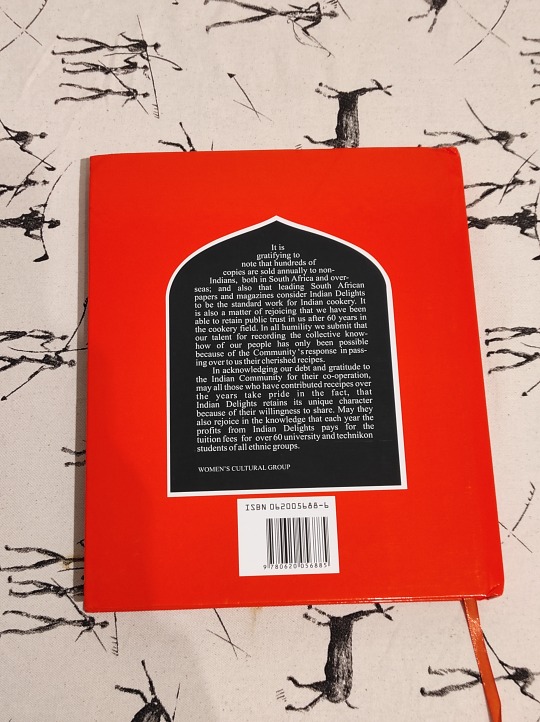
It's Indian Delights, the de facto standard book of South African Indian cooking. Assembled in the 60's by the Durban Women's Cultural Group and in print ever since then.
The How
A birthday gift from my parents, who sent it from South Africa.
There are apparently places that carry this book outside of South Africa but I do not know what those are.
The Text
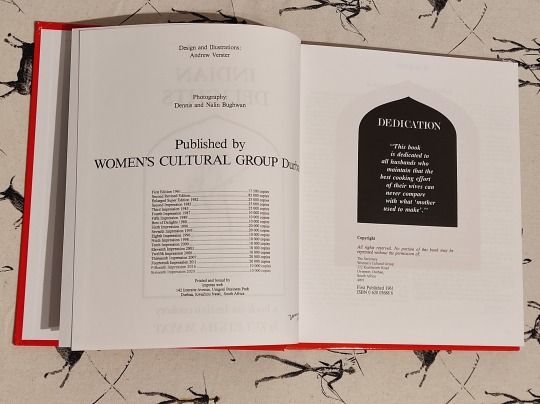
Dubious, but useful despite this. It was written in the 60's by a bunch of people who had never and would never again write a recipe book. You may note from the frontmatter that while it has had sixteen impressions since its first publication in 1961, there has only ever been a single revision of the book. There are numerous errors, omissions, and flaws. Recipes may list ingredients that are not used, call for ingredients in the method not given before, begin preparing components and never use them, or outright lie about the quantities of ingredients you need. A challenging exercise.
Any given individual's copy of this book is full of little pen notes, slips of paper, and scratched out experiments. I have a blank canvas.
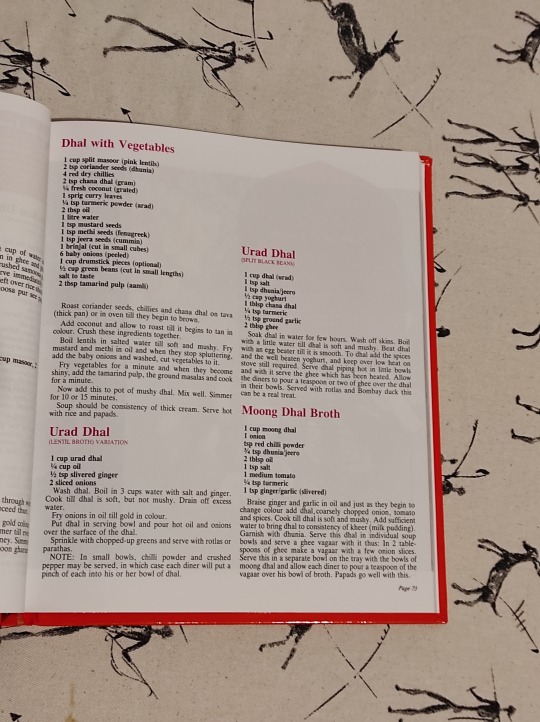

It is absolutely stuffed to the brim with recipes from the then-almost-century of South African development on South Asian cuisine. It is intended as a one-stop-shop for cooking from a diaspora of extremely wide origins.
South African Indians arrived in South Africa as indentured labour for British sugar farms and could just as easily be from the relatively cold and mountainous North Indian regions or the low, rainy, hot coastal areas of South India. As a result you've had almost a hundred years of adapting to the locally available ingredients, intermarriages across wide geographic origins, and failing memories. There are frequently many duplicates of any given recipe, each with some unique variation of note.

It is also extremely dated. It still lives in an era where "adding an elachi (cardamom) pod to your rice" is a luxurious choice that requires financial considerations, and where meat was still expensive. It also has a delightful section on mass cooking, such as the above "Biryani for 100 people" which has an additional note on the ingredients for a "Biryani for 800 people" on the opposite leaf. These things come up sometimes, although the largest biryani I've ever been involved in was for about 60 people.
It is not really for beginners but it does have a lot of introductory matter, in part because it has to contend with the mishmash of languages and loanwords that exist. You don't know if the reader uses the hindi word for cumin, or the tamil word for cumin, or makes a formal distinction between roti and chapati. As a result, there are extensive opening tables of translations.
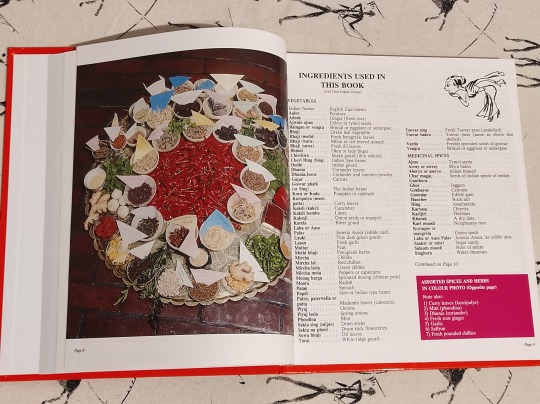
The Object

Big, blocky hardcover recipe book. Cheap but hardwearing coated pages. I have seen these in every imaginable state of disrepair, unfortunately I do not have a photo on hand of my mother's which is completely beat to hell.
I mentioned that there have not been many updates, and this continues to the outside. Not a single impression has, for example, corrected the misalignment of the spine and the cover that means it stands out on any book storage system.

Some damage to the cover from the rigours of air travel. It'll recover, or rather, it'll get beat up in ways that make that negligible.
The photography is antiquated, having been taken by a photographer who was certainly good but was operating a) with 1961 camera technology, b) 1961 photographic sensibilities, and c) no real experience in food photography. As a result the images can look somewhat alien if you're familiar with more modern food photograpy. Colours are not accurate, framing is flat, and composition is often packed.
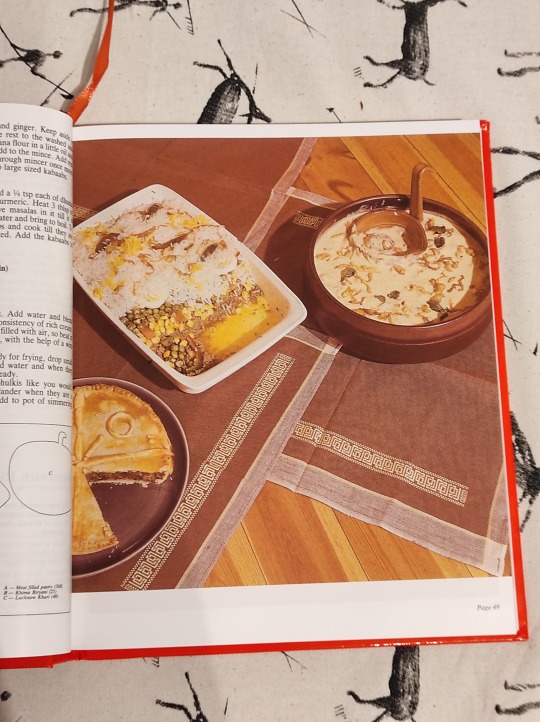
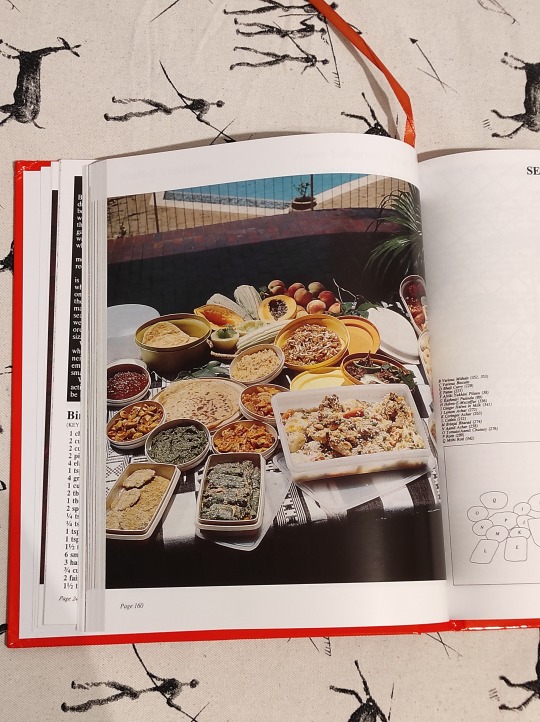
In addition to the colour glamour plates, there are black and white instructional photos, which are much more timeless.

The Why, Though?
Indian Delights is a very important cultural reference for the South African Indian population, and it's a pretty standard leaving home/getting married/leaving home and getting married gift. I've bought a copy for many friends and now this one is mine.
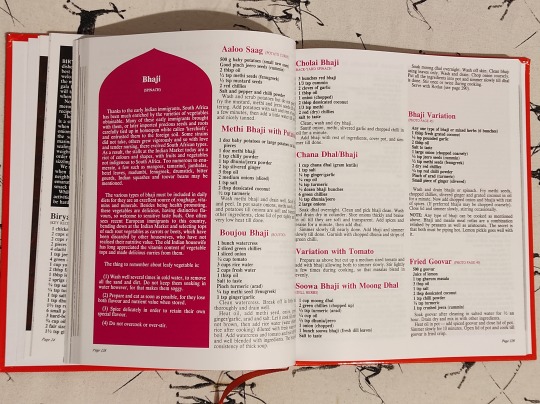
Will I actually use this much? Certainly not that often. My mother and her sisters learned to cook from this book, so it is the root of my personal culinary tradition. That means I already know a lot of what can be distilled from this for day-to-day recipes. Where it is handy is for more technical dishes, which require some guidance, or as an ingredient reference for something new you want to try.
In particular Diwali is coming up and while both my mother and I are staunch atheists, we will also take any excuse to make a ton of sweets for friends. If you are in Prague in the week of the 12th of November you can probably hit me up for something.
Listening: Acheney is a shockingly talented synth designer for the niche softsynth tracker sunvox, available now on windows, mac, linux, windows CE, android, and iOS. I was tooling around with their Guitar synths and decided to check out their music, which is a couple albums of very high concept EDM inspired ambient and/or noise stuff. Here's Euler Characteristic Zero
Watching: @humansbgone is an animated sci-fi series about intelligent giant arthropods and their attempts to deal with invasions of pesky little humans
youtube
Big spec-bio focus with a lot of end notes on the arthropods in question.
Playing: Played the Trans Siberian Railway Simulator demo, which I recorded and put up here, with crap audio because it's authentic to what I had lying around after I forgot my headphones at work.
youtube
Also: the digital version of the D&D themed agent placement game Lord of Waterdeep with my family, which works quite well. It's weird to have the game handling the admin of moving points around and automatically deducting resources, but it does make the game go very quickly, even if your parents are still figuring out the interface.
Making: Big cooking experiment with a slow roast lamb shank. Came out very well. Lamb shank definitely one of the more animal parts of an animal you can cook. Smells intensely of lanolin and other hair smells. Real greasy. Big honkin' bone. Smooth and fine but sturdy musculature. This thing used to be a very specific part of something alive and that thing lived the kind of life that develops the very particular smells of the insides of a sheep that are very close to the outside of a sheep. You will find some wool fibers in your pan from where the follicles reach down close to the bone and sinew.


Tools and Equipment: Easyeffects is the successor to PulseEffects and is a very complete set of audio tuning and manipulation tools for Linux. You can use it to process incoming and outgoing audio with basically any plugin you care to imagine.
#last monday of the week#Bandcamp#food#indian delights#south africa#recipe books#untitled wednesday library series
31 notes
·
View notes